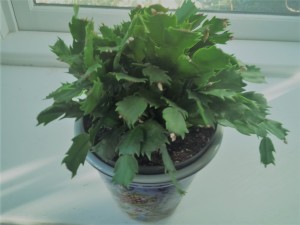 Three decades ago, the late American humorist, Erma Bombeck, published a book titled, The Grass is Always Greener Over the Septic Tank. I don’t have a septic tank, so I can’t attest to the validity of that statement, but I do know that the houseplants are always healthier over the microwave.
Three decades ago, the late American humorist, Erma Bombeck, published a book titled, The Grass is Always Greener Over the Septic Tank. I don’t have a septic tank, so I can’t attest to the validity of that statement, but I do know that the houseplants are always healthier over the microwave.
There is probably a book in that, too.
The microwave in question is a freestanding unit that sits on a countertop in a corner of my kitchen. It is flanked on one side by the refrigerator, and on the corner by two windows. One window faces north and the other east. They are not always sparkling clean.
The top of the microwave is generally bare in the summer, but during late fall, winter and early spring—any time night temperatures fall below 50 degrees Fahrenheit–the microwave top is home to a number of plants. Most recently this array included a large pot of second and third year amaryllis bulbs, a parlor maple, a Rex begonia, a small moth orchid and a soon-to-be dormant cyclamen left over from last Christmas. All flourished, except perhaps the cyclamen, which was going through a predictable ugly phase on its way to its annual dormancy period.
With the exception of amaryllis, I have failed repeatedly with the plant species flourishing atop the microwave. Rex begonias are a perfect example. The pundits say that these specimens, with their showy leaves, need just the right amount of water, relatively high humidity and moderate day and night temperatures. My main indoor plant area is a large window seat in the dining room, which has relatively low humidity during the cold weather months. I try to water my dining room denizens intelligently and I make an effort to position the Rexes away from heat sources. Despite my best efforts, a succession of lovely Rexex have started a slow, inevitable decline about two days after arriving from the nursery.
I thought that I was personally toxic to Rexes until I ran out of dining room space and perched one atop the microwave. After a week it looked as good as the day it arrived. After a month, it seemed to be flourishing. Now, some five months later, it has gone outside to a protected shady spot, joined by another Rex that I bought three weeks ago in a fit of unbridled begonia optimism.
I am not an orchid fanatic, but from time to time I have acquired or been given moth orchids or Phaleanopsis. All the guides say that these exotic creatures, which have become ubiquitous due to tissue culture propagation methods, are the easiest orchids to grow. In my house, they have been the easiest orchids to kill, and I have done so repeatedly.
In a triumph of hope over experience, I bought a small one in January. I potted it up in orchid mix, propped up its bloom stalk with a small stake and set it atop the microwave. In keeping with its cultural needs, I submerged the pot in water once a week for fifteen minutes before letting it drain and returning it to the microwave. It is still alive, the roots seem plump and green and the leaves look healthy. I am hoping that it will bloom again in the winter, at which time I will feel like a horticultural genius.
Most people toss their holiday cyclamens after the blooms fade, but I love the marbled foliage and orchid-like flowers. Too often, though, my cyclamens have refused to hold onto those gorgeous leaves after the flowers fade, setting forth on the lonely path that leads inevitably to the compost pile.
My microwave cyclamen held its leaves for four months before gradually losing them. This gives me hope for future regeneration, so I have marked the calendar for a date in the fall when I will restart the watering and feeding cycle. Even if the return performance is lackluster, I will feel like a great success.
My inner Victorianist has long coveted the parlor maple or abutilon, which is not really a maple at all, but a member of the mallow clan, related to hibiscus. A healthy parlor maple is a small shrubby plant with maple-like leaves and lots of gorgeous hollyhock-like blooms. In at least three instances, a parlor maple on my premises has turned rapidly into a collection of barren twigs.
The parlor maple that spent the last several months on the microwave is a healthy, 18 inches tall and has already produced two flowers. It has now migrated to the back porch for a summer vacation. I am cautiously elated.
What is it about the microwave that produces these results? I wish I knew. It might be that plants thrive with low levels of escaped microwave radiation, or generous doses of fumes from reheated leftovers. The light situation may be optimal for some plants. After all, dirty windows can be can be easily characterized as “diffused light situations”. Since the various pots are in the kitchen, I tend to pay more attention, which may be a factor. I also have to extend my reach to water, preventing overwatering and averting root rot.
I am afraid that if I overanalyze the situation, I will jinx the plants, so I will not conduct controlled studies or sift through horticultural literature to find answers. A combination of serendipity and ignorance seems to be the best course of action–as long as the microwave stays in the same place.
